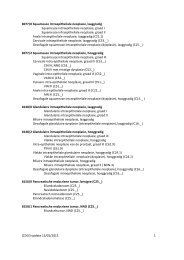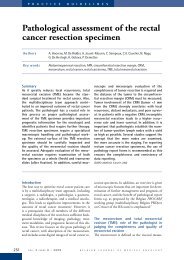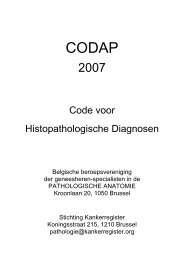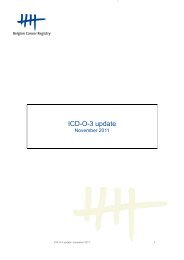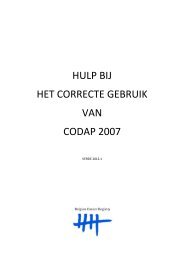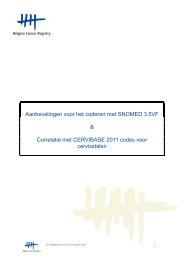Assurance de qualité pour le cancer rectal – phase 2 ...
Assurance de qualité pour le cancer rectal – phase 2 ...
Assurance de qualité pour le cancer rectal – phase 2 ...
Create successful ePaper yourself
Turn your PDF publications into a flip-book with our unique Google optimized e-Paper software.
KCE Reports 81 PROCARE <strong>–</strong> <strong>phase</strong> 2 92.2.2 Overview of se<strong>le</strong>cted quality indicators2.2.2.1 General quality indicatorsFour general QI were se<strong>le</strong>cted:• Overall 5-year survival by stage (QI 1111) (high <strong>le</strong>vel of evi<strong>de</strong>nce)• Disease-specific 5-year survival by stage (QI 1112) (high <strong>le</strong>vel of evi<strong>de</strong>nce)• Proportion of patients with local recurrence (QI 1113) (high <strong>le</strong>vel ofevi<strong>de</strong>nce)• Proportion of patients discussed at a multidisciplinary team meeting (QI1114) (low <strong>le</strong>vel of evi<strong>de</strong>nce)Both overall and disease-specific 5-year survival by stage and the local recurrence ratewere i<strong>de</strong>ntified in the literature [3, 4]. Another QI on survival (relative 3-year survival)was i<strong>de</strong>ntified on the website of the Clinical Indicator Support Team (CIST)(http://www.indicators.scot.nhs.uk/). Both survival and local recurrence rate are affectedby most processes of <strong>rectal</strong> <strong>cancer</strong> care [1]. In fact, several studies have conclu<strong>de</strong>d thatusing combined modalities and total meso<strong>rectal</strong> excision (TME), local recurrenceremains acceptab<strong>le</strong> (< 10%), with overall survival of 64% compared with conventionalsurgical techniques, where local failure rate was 27% [8].Disease-free survival (DFS) is frequently used as an outcome in clinical studies. In ouropinion, DFS is sufficiently covered by using disease-specific 5-year survival and localrecurrence rate as QI.Several QI were i<strong>de</strong>ntified referring to the importance of a multidisciplinary approach inthe work-up of <strong>rectal</strong> <strong>cancer</strong> [3-6]. Several recommendations in the PROCARE CPGstress the need of such a multidisciplinary approach, although the supporting evi<strong>de</strong>nce islow [1]. In Belgium, a specific nomenclature co<strong>de</strong> is availab<strong>le</strong> for a multidisciplinaryoncologic consultation (see below). It was therefore <strong>de</strong>ci<strong>de</strong>d to merge all i<strong>de</strong>ntified QIinto 1 QI referring to this multidisciplinary consultation.2.2.2.2 Quality indicators related to diagnosis and stagingSeven QI related to diagnosis and staging were se<strong>le</strong>cted:• Proportion of patients with a documented distance from the anal verge(QI 1211) (low <strong>le</strong>vel of evi<strong>de</strong>nce)• Proportion of patients in whom a CT of the liver and RX or CT of thethorax was performed before any treatment (QI 1212) (mo<strong>de</strong>rate <strong>le</strong>vel ofevi<strong>de</strong>nce)• Proportion of patients in whom a CEA was performed before anytreatment (QI 1213) (mo<strong>de</strong>rate <strong>le</strong>vel of evi<strong>de</strong>nce)• Proportion of patients un<strong>de</strong>rgoing e<strong>le</strong>ctive surgery that had preoperativecomp<strong>le</strong>te large bowel-imaging (QI 1214) (low <strong>le</strong>vel of evi<strong>de</strong>nce)• Proportion of patients in whom a TRUS and pelvic CT and/or pelvic MRIwas performed before any treatment (QI 1215) (mo<strong>de</strong>rate <strong>le</strong>vel ofevi<strong>de</strong>nce)• Proportion of patients with cStage II-III that have a reported cCRM (QI1216) (mo<strong>de</strong>rate <strong>le</strong>vel of evi<strong>de</strong>nce)• Time between first histopathologic diagnosis and first treatment (QI 1217)(low <strong>le</strong>vel of evi<strong>de</strong>nce)The distance from the lower edge of the tumour to the anal verge is an importantclinical parameter, since it co-<strong>de</strong>termines the indication for neoadjuvant treatment, thetype of surgery and outcome [1]. This QI was i<strong>de</strong>ntified through the literature search[5, 6], and <strong>–</strong> although supported by low-quality evi<strong>de</strong>nce <strong>–</strong> was <strong>de</strong>emed very re<strong>le</strong>vant bythe project team.The aim of imaging techniques such as CT, MRI and PET is to <strong>de</strong>tect hepatic and extrahepaticmetastatic disease [1].



